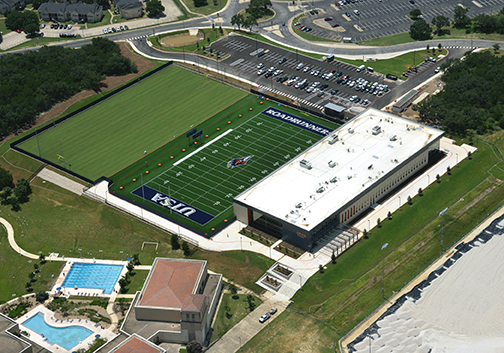UTSA Opens $40M Athletics Center
The University of Texas at San Antonio in San Antonio, Texas, recently opened its new $40.4-million athletics center. A news release calls the Roadrunner Athletics Center of Excellence (RACE) “a milestone in the university’s strategic vision to create a central hub for UTSA Athletics and to further promote the academic success, health, wellness and performance of the university’s student-athletes.” The center covers about 10.8 acres in the southwest corner of UTSA’s main campus, and the facility itself measures in at almost 95,000 square feet.
“Great universities have exceptional academic, research and athletics enterprises. The addition of RACE will further propel UTSA to national recognition while advancing our success as Division I competitors in Conference USA and generating a great sense of pride for San Antonio,” said UTSA President Taylor Eighmy. “I am grateful for the support of Gene Dawson and the Roadrunner Foundation Board, the leadership of our Vice President for Intercollegiate Athletics Lisa Campos, the partnership of the City of San Antonio, and the generosity of so many donors who helped bring RACE to life.”

Photo Credit: Joeris General Contractors
The project was funded through philanthropic gifts, a 2017 bond referendum from the City of San Antonio, and Roadrunner Foundation financing. The university partnered with architect-of-record Populous as well as local architecture firm MarmonMok. Joeris General Contractors served as the construction firm and Project Control as the project manager.
Amenities of RACE include 7,000 square feet of academic space including a study hall, tutoring rooms, a computer lab, and classroom and office space; a sports medicine center with treatment areas, an enclosed hydrotherapy room, and aquatic therapy equipment; a 14,000-square-foot strength and conditioning center; two practice fields; a 7,500-square-foot locker room with 120 lockers; and multiple meeting rooms.
“At UTSA, student success is at the core of everything we do. We are committed to providing all of our students, including our student-athletes, with the very best environment to enable them to achieve their full potential,” said Lisa Campos, UTSA vice president for intercollegiate athletics and athletics director. “Just as UTSA is becoming an exemplar in academics and research, UTSA Athletics is increasingly gaining national recognition. RACE will have a long-lasting impact in further propelling UTSA’s stature as a Division I competitor. It is foundational to the Athletics priorities of UTSA’s Be Bold capital campaign.”
The second phase of the facilities project involves installing a covered pavilion over one of the practice fields. Fundraising for that phase is currently in progress.
“When I first arrived in San Antonio, my good friend Red McCombs wisely shared with me that our athletics program is the front porch to our university,” Eighmy said. “Intercollegiate athletics is integral to the college experience for our student-athletes, our university community and our alumni and friends in San Antonio, in Texas and across the globe. Today is a very special day that is foundational for the future of UTSA Athletics. We look forward to building on this momentum and seizing the opportunities that lie ahead.”
About the Author
Matt Jones is senior editor of Spaces4Learning. He can be reached at [email protected].